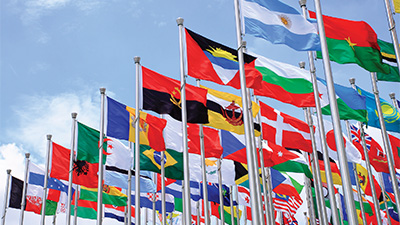Globalization c. 1900 to the Present
Teacher Resources
Driving Question: How did new global connections and innovations affect different parts of the world from c. 1900 to today?
From the start of the long nineteenth century to today, humanity experienced rapid changes as industrialization and globalization reshaped societies in every corner of the world. As we continue to grapple with our connections, diversity, and inequalities today, this unit asks how the stories of our past inform our present, and how they will shape our future.
Learning Objectives
- Assess the degree to which technological innovation and other changes have created a single human community over the past century.
- Analyze the causes and effects of environmental changes during this period.
- Evaluate the continuities and changes as well as the costs and benefits of economic globalization from 1900 to the present.
- Investigate how social structures, roles, and practices have stayed the same and changed over this period.
- Explain how and why globalization has led to cultural changes from 1900 to the present, and analyze the various responses to these changes.
- Use historical thinking skills and reasoning processes such as claim testing, causation, sourcing, and continuity and change over time to evaluate historical events and processes.
Vocab Terms:
- Anthropocene
- climate change
- consumption
- environment
- globalization
- gross domestic product (GDP)
- regulation
Opener: Globalization c. 1900 to the present
To teach this lesson step, refer to page 2 of the Lesson 9.0 Teaching Guide.
What do we mean when we talk about globalization? Make some predictions about what you’ll learn in this unit.
Unit 9 Overview
To teach this lesson step, refer to page 3 of the Lesson 9.0 Teaching Guide.
Looking for more support using video in the classroom? Check out the blog post Engaging students with video.
In this course, you’ve encountered trends such as the growth of political rights, the increasingly interconnected nature of global economic systems, and the emergence of new technologies that enable faster and more sustained communication. How have these revolutions impacted people differently around the world?
-
Guiding Questions
-
Before you watch
Preview the questions below, and then review the transcript.
While you watch
Look for answers to these questions:
- How do changes in the child mortality rate from 1800 to the present show us that advances in medicine have been unequal?
- Why is the period after 1945 sometimes referred to as “the Great Acceleration”?
- How has globalization created a “flatter” world and how has it created a “lumpier” world?
- How has globalization positively and negatively affected cultural developments and interactions?
- How is climate change both a global problem and an unequally shared one?
- How have globalization and climate change impacted the spread of malaria?
After you watch
Respond to the following question: John Arthur presented a few examples of the positive and negative effects of globalization. What are two additional examples of how globalization has impacted our world, either positively or negatively?
Key Ideas
Unit 9 Introduction: Globalization, 1900–Present
To teach this lesson step, refer to page 4 of the Lesson 9.0 Teaching Guide.
The era of intense globalization can be viewed through five themes: environment, culture, rights and resistance (governance), economics, and technology—explore how in the article below.
-
Guiding Questions
-
Before you read
Preview the questions below, and then skim the article. Be sure to look at the section headings and any images.
While you read
Look for answers to these questions:
- How and when did the stories of decolonization and the Cold War end?
- When did globalization begin, according to the author? What does it mean to call the era after the Second World War up to today an era of “intense globalization”?
- How has globalization affected our environment?
- What is the Anthropocene?
- What was the economic impact of the end of the Cold War?
After you read
Respond to the following question: At this point, would you argue that globalization has been a positive or negative trend for the human species as a whole since 1945? What is the evidence?
Closer: Globalization c. 1900 to the present
To teach this lesson step, refer to page 5 of the Lesson 9.0 Teaching Guide.
The Themes Notebook is similar to the Unit Notebook in other OER Project courses. Check out Unit Problem and Vocab for some great ideas on bringing this informal writing routine into the classroom.
You’re pretty accustomed to the AP themes and the Themes Notebook at this point in the course. Take a stab at identifying the themes that will be important in this unit.



